Play Your Child’s Way!
“Play is often talked about as if it were a relief from serious learning. But for children, play is serious learning. Play is really the work of childhood.”
-Fred Rogers
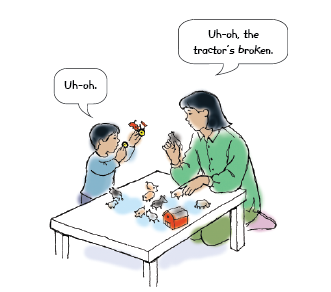
There’s no better time for your child to learn about communicating than when they’re playing. It’s during play that children learn about the objects in their world, as well as a lot about communication, including:
- how to take turns and have interactions
- what words mean
- how to share their interests
- how back-and-forth communication works
There are countless opportunities for your child to practice communicating as you play together. Most importantly, play is fun! And when children are having fun, they are more likely to learn new things. But to make the most of playtime, you’ll need to play your child’s way!
Playing your child’s way means noticing what your child is doing and joining in, without changing the play or having your own plan. If you play your child’s way, your child will be more likely to notice you, as well as what you’re doing and the things you’re saying. In this way, your child will learn a lot from you, all while having fun!
Here are 3 tips to help you play your child’s way:
1. Observe, Wait, and Listen (OWL™)
The first step is to stop what you’re doing and wait, observing your child closely and listening to what they’re saying. This will help you figure out what your child likes to play with, how they like to play, and what they want to talk about. Below, this mom notices her son playing with farm animals. But when she observes, waits and listens, she discovers that he really wants to talk about how the tractor is missing a wheel. If she talks about the tractor (instead of the animals), it’s more likely to start an interaction and help him learn new words, like “broken.”

2. Join in and play like a child
Join in the fun and play the way your child is playing. Don’t try to change it or tell your child what to do. There’s no “right” way to play. Try to look at play through your child’s eyes and think about what’s caught their attention and what’s fun about the action or activity.
One simple way to play like a child is to copy what your child does. If your child pushes a train around a track, get another train that you can push around the track. If your child wants to dump water from a cup in the bathtub, grab your own cup and do it too. If your child would rather hide farm animals instead of putting them in the barn, you can take turns hiding animals, like this mom:
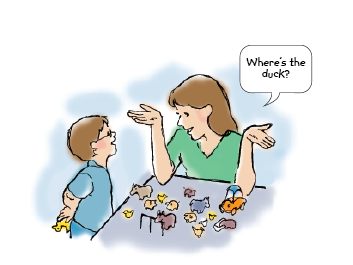
When you copy what your child does, it’s a great idea to get your own toy. This makes it easier to join in and to avoid just watching from the sidelines without actually playing yourself. Some toys come in multiples so it’s easy to get your own toy, such as farm animals, a train set, or blocks. If your child is playing with a toy that doesn’t have multiples, grab something that is similar to your child’s toy. For example, if your child is beating on a toy drum with drumsticks, grab some wooden spoons and beat on either your child’s drum or your own “drum” made by turning a pot upside down. Or if your child is pushing a bus along the floor, grab another vehicle and push it alongside your child’s bus.
If your child likes pretending, another way to play your child’s way is to take on a role that fits with whatever your child is pretending about. When you take on a pretend role, you do and say things that your pretend character would. For example, if your child has lined up chairs and is pretending to drive a “bus”, you can pretend to be a passenger by handing your child a pretend “bus ticket” and sitting down in one of the chairs, pretending to go for a ride. Or, if your child is pretending to cook, you can pretend to be a customer at their “restaurant”, doing things that a customer would do, like Dad does below:
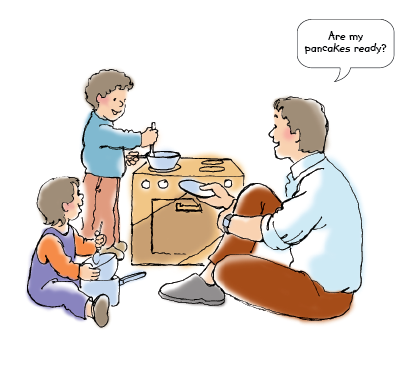
The important thing to remember when you play your child’s way is to stick with your child’s interests and play like your child does.
3. Add language to the play
Once you’ve joined in, you can add some language to the play. Playing your child’s way means talking in a fun, playful way about what you and your child are doing. It’s much more motivating for your child to communicate with you when you add language in a playful way than if you have your own agenda and try to get your child to talk. You can see the difference in the pictures below:
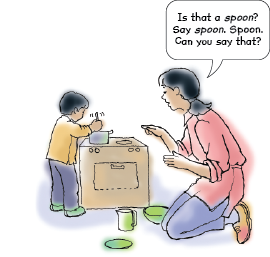
In this picture, mom is trying hard to get her child to say the word “spoon.” But he doesn’t notice her or what she’s saying because she’s not playing his way or adding language in a fun, playful way.
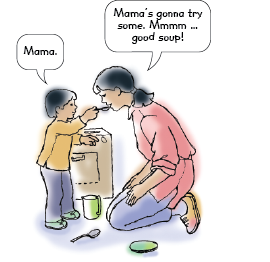
Here, mom joins in the play, responding with interest to what her child is doing. Now they're playing and communicating together! He's more likely to learn new words because he's having fun with mom.
Besides making comments about what you and your child are doing, you can also add some sound effects and fun words like “whoops!” “pop!” “vroom vroom,” “woof woof,” or “yummmmy!” These words tend to catch young children’s attention because they are said with a lot of animation. Sometimes children imitate these types of words before they imitate other words. Below, mom copies the sound her son makes, and adds a fun word: “bang, bang!”
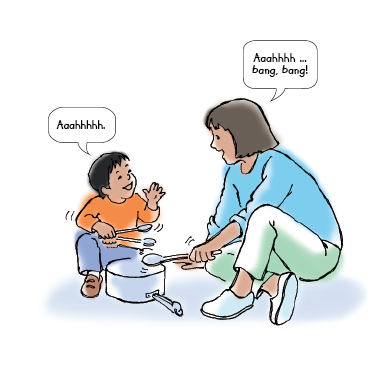
It’s easy to join in and have fun with your child if you play your child’s way. And while your child is busy having fun with you, they won’t even notice that they are learning all about communicating while you talk and play together!
Similar articles by tag:
